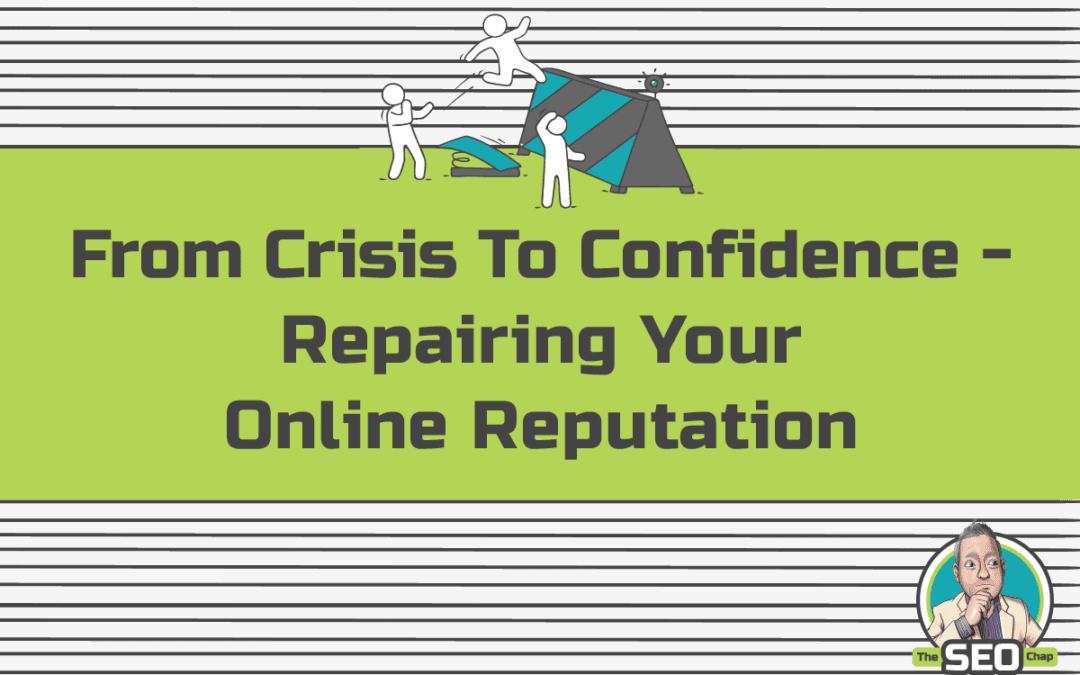In today’s digital world, having a positive online reputation is essential for any business. It’s the key to gaining customers trust and building a successful brand.
Unfortunately, even the best companies can experience crisis and repairing your online reputation is required at some point. Whether it’s due to bad reviews on social media, damning forum posts or negative press coverage, it can be difficult to recover from these types of crises without taking proactive steps.
In this article, I’ll guide you through the basics to repairing your online reputation and discuss strategies for regaining customer confidence.
Understanding the Basics of Repairing Your Online Reputation
Taking control of how people perceive you online is essential for feeling secure and successful in the digital world. Repairing your online reputation starts with embracing humility and seeking feedback from others.
Acknowledging mistakes, taking responsibility, and learning from them can be challenging, but it’s necessary for growth. It’s important to remember that everyone makes mistakes; don’t let the fear of making one stop you from trying new things or speaking up when needed.
The next step in online reputation management is to stay active on social media platforms and engage positively with other users. Monitor any reviews or comments about yourself – both positive and negative – so that you can respond appropriately if needed. Be sure to thank those who leave positive reviews as it shows appreciation for their feedback as well as encourages future customers to leave good reviews too.
When managing an online presence, staying aware of what information is being shared about you by others is critical. Not only does this help protect your privacy, but it also allows you to take steps towards correcting any misinformation out there about yourself. When possible, contact the person directly or reach out to a third-party source like Google Reviews or Yelp for assistance if needed.
Conducting a Self-Assessment
To get a sense of your current standing, it’s time for a self-assessment – taking stock of what you’ve got. A great place to start is by providing feedback to yourself about your online presence. This includes everything from the content posted on social media accounts to reviews and ratings people have left for your business or product.
Be honest with yourself about any mistakes that may have been made in the past, such as posting something inappropriate or not responding quickly enough to customer inquiries. Then, make an action plan to fix these mistakes:
-
- Make a list of all places where you have an online presence
- Take detailed notes on what needs improvement and be sure to include how this can be accomplished
- Reach out to customers directly who had negative experiences with your brand
- Create new content which reflects positively on your business or product
You can also enlist the help of friends, family members, and colleagues who can provide additional insight into how well you are managing your online reputation. They may spot things that you missed or suggest ways in which you could improve it even further. Taking this advice onboard is important since they’re more likely than anyone else to know if something isn’t quite right with your digital presence.
Making Transparency a Priority
Gaining the trust of your customers is essential, and making transparency a priority can help you do just that. When it comes to repairing your online reputation, embracing mistakes and being open about any missteps is key in building trust with your customers.
Being transparent about areas where you may have faltered or need additional work helps to show that you’re taking responsibility for the situation. This builds credibility and shows that you care about providing quality service to your customer base. It also shows that you’re willing to learn from any mistakes and make changes as needed to improve your services.
If something goes wrong, take ownership for it and communicate openly with customers about how you plan on addressing the issue. Showing them that their feedback matters will go a long way towards restoring confidence in your business practices. Acknowledge what went wrong, explain why it happened, provide an update on progress made so far, and let customers know when they can expect a resolution.
Be sure to also address any negative comments or reviews head-on: thank people for taking the time to leave feedback, then provide an honest explanation of the steps taken so far (or will be taken) in order to resolve the problem as quickly as possible.
Keeping communication lines open with customers shows them that they matter and gives them insight into how seriously issues are taken within your organisation – this should help strengthen overall customer relationships going forward.
Taking Control of Your Online Presence
Gain control over how you’re perceived online by taking ownership of your online presence. It’s essential to maintain a positive digital footprint as it can be beneficial in many areas of life.
You can do this by engaging with your community and building relationships with others through proactive strategies. This helps create a strong network that will be supportive when it comes to managing your reputation. Additionally, creating content on social media platforms and other outlets can help shape the narrative about yourself and ensure that it remains positive.
By being mindful of what you post online, you’re in control of the message you send out into the world. This means avoiding any posts or comments that could potentially damage your reputation, such as negative criticism or inflammatory statements.
Furthermore, staying up-to-date on current events allows for more informed conversations and interactions with others in your area of expertise or interest. By engaging with people who share a similar outlook, it can help build credibility as well as open up opportunities for collaboration or growth.
Taking charge of how you come across online is key for ensuring a positive image is maintained over time. Utilising various social media channels combined with thoughtful communication makes it possible to establish trust among peers while protecting yourself from potential reputational risks at the same time.
Doing so allows for greater freedom when interacting online without compromising your public profile in any way.
Utilising Social Media Monitoring Tools
Take control of your online presence with the help of social media monitoring tools, and start building a positive digital footprint today. Social media monitoring tools can help you identify triggers that are causing negative conversations about your brand and take swift action to avoid further damage to your reputation. They can also be used to cultivate relationships with customers by encouraging them to engage in positive conversations about your brand.
Here are some key benefits of using social media monitoring tools:
-
- Increase visibility into customer sentiment: You’ll be able to capture, track, and analyse customer sentiment on various platforms so you can adjust your strategies accordingly.
- Monitor competitor activity: Keep tabs on competitors to see how they’re interacting with their customers and what strategies they’re using.
- Avoid negativity: With the ability to quickly identify any potential negative posts or comments regarding your brand, you’ll be able to respond promptly before any damage is done.
Social media monitoring tools provide invaluable insights into the conversations taking place around your brand. This allows you to proactively manage its online reputation while avoiding any potential negativity that could arise from mismanagement or lack of awareness.
Crafting Engaging Content
Discover how to craft engaging content that will help boost your brand and build relationships with customers. Crafting engaging content is essential for any branding strategy in order to make a lasting impression on potential customers and build relationships with existing ones.
Content curation requires an understanding of the target audience’s interests and needs, which can be achieved through social media monitoring tools like keyword tracking, sentiment analysis, trend reports, etc. Having an understanding of what your target audience wants allows you to create quality content that resonates with them.
Additionally, finding ways to engage your audience such as offering rewards or running giveaways helps not only in building relationships but also in boosting brand visibility among potential customers. When crafting content, it is important to remember that quality always trumps quantity – creating multiple pieces of low-quality or irrelevant content will do more harm than good for your reputation online.
Employing SEO techniques such as selecting the right keywords and optimising page titles can help ensure that your posts are seen by the right people at the right time. Also consider repurposing popular kinds of content such as infographics or videos – these types of visuals tend to get higher engagement rates than plain text posts alone.
Finally, use analytics tools wherever possible so you can measure the success of each post and adjust accordingly if needed; this way you can maximise ROI from every piece of content created.
Monitoring and Responding to Reviews
Now that we know how to craft engaging content, let’s discuss the importance of monitoring and responding to reviews. This is an essential part of any online reputation management strategy as customers rely heavily on these reviews when making decisions.
Reviews also give businesses insights into what customers think about their products or services and can help them improve the customer experience. It’s important for businesses to have clear reviewing policies in place so that they can respond appropriately to negative feedback and address any problems before they become serious issues.
Being able to engage with customers directly shows that a business cares about their opinion and takes it seriously. Businesses should focus on finding solutions for customer issues rather than just pointing out the problem itself.
Responding promptly and empathically to customer reviews is key in order to maintain a positive online presence. It’s an opportunity for businesses to show potential customers that they care about their experiences while also providing helpful information if necessary.
Taking time out to thank customers who leave positive feedback is also important since it builds trust and encourages repeat business as well as word-of-mouth recommendations from satisfied customers.
Leveraging Reputation Management Services
Managing an online reputation can be difficult, so leveraging specialised services to help can be a great way to ensure success. When it comes to repairing your online reputation, there are several options available and engaging expertise can make the process much easier.
Here are some of the advantages of using a reputation management service:
-
- You have access to experts with experience in the field who know what tactics work best and how to navigate the minefield of public opinion.
- You get personalised advice tailored specifically for your unique situation, based on their experience with other clients.
- You save time by not having to research all of the available options yourself or keep up with changes in technology or public opinion.
- Reputation management services also provide tools for monitoring and responding quickly to negative reviews or comments about you or your business.
- They give you peace of mind knowing that your online presence is being monitored and any potential problems are addressed immediately.
By utilising a reputable reputation management service, you can rest assured that all aspects of managing your online presence will be taken care of in an efficient and professional manner. Not only will this help restore your confidence after experiencing a crisis, but it will also give you valuable insights into improving your public image going forward.
Taking proactive steps now could prevent future issues from arising in the future!
Conclusion to Repairing Your Online Reputation
If you manage this points, you will have come a long way to repairing your online reputation. You will now be proactively monitoring and responding to reviews, crafting engaging content and taking control of your online presence.
With the right strategies in place, I’m confident that you can continue to protect and build your reputation further. The key is to stay vigilant: keep assessing your digital footprint, make transparency a priority, and utilise social media monitoring tools so you can ensure your brand is well-represented wherever it appears online.
With these steps taken care of, you can confidently move forward with an improved presence on the web.


